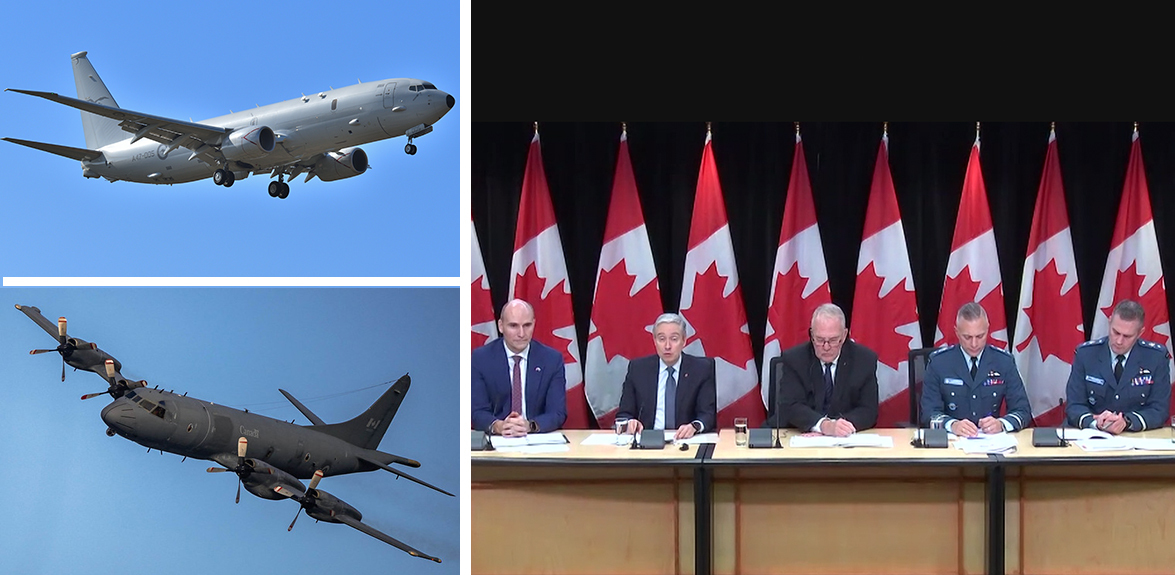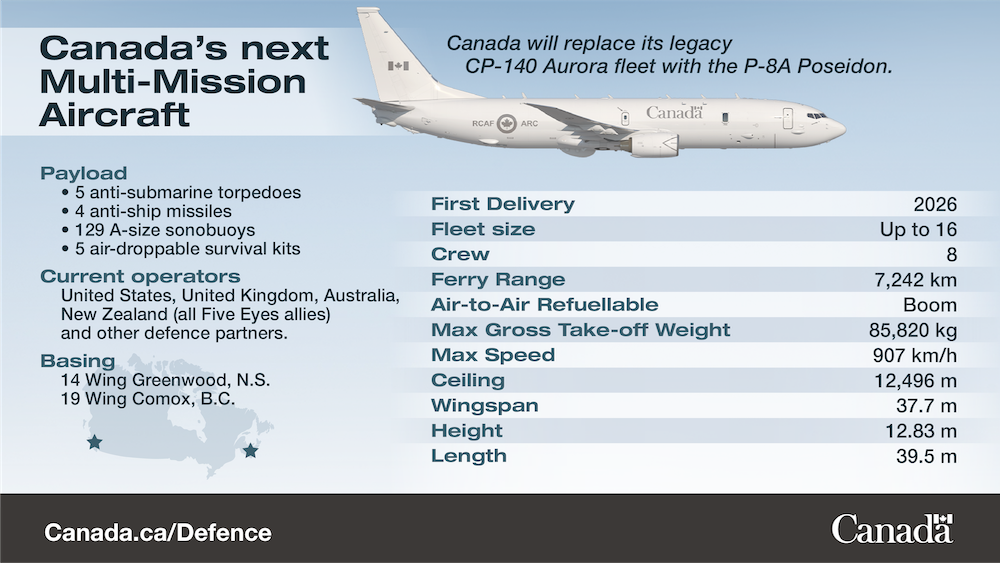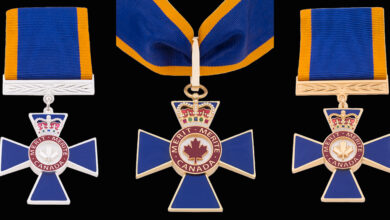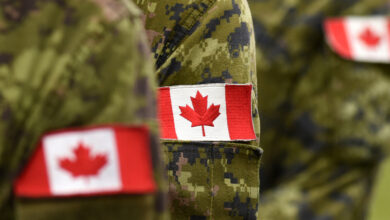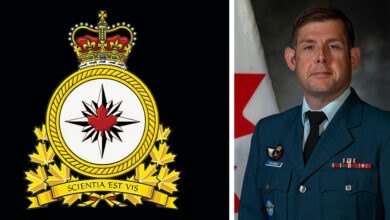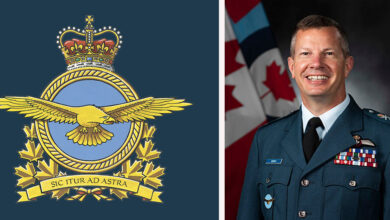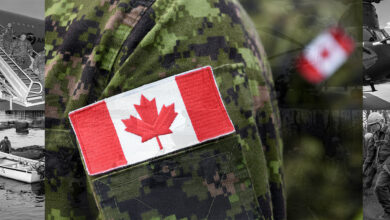Policy
A “Good Day” for RCAF as Government Announces Boeing P-8A Poseidon Procurement
Above image: top left, P-8A Poseidon Multi Mission Aircraft, bottom left, CP-140 Aurora, right, from the press conference (see below).
The Royal Canadian Air Force is set to receive up to 16 P-8A Poseidon Multi Mission Aircraft.
On Nov. 30, government officials announced a finalized government-to-government agreement with the United States to acquire up to 16 P-8A Poseidon aircraft for the Royal Canadian Air Force (RCAF).
“In today’s complex global environment, Canada requires a military that is capable of protecting our country well into the future. We are committed to ensuring that our current and future aviators have the most advanced equipment possible to do just that. Canada requires a multimission fleet to contribute to the safety and security of Canadians and protect the sovereignty of a country with the longest coastline in the world. The Boeing P-8A Poseidon is the right aircraft to fulfil this role,” said Minister of National Defence Bill Blair.
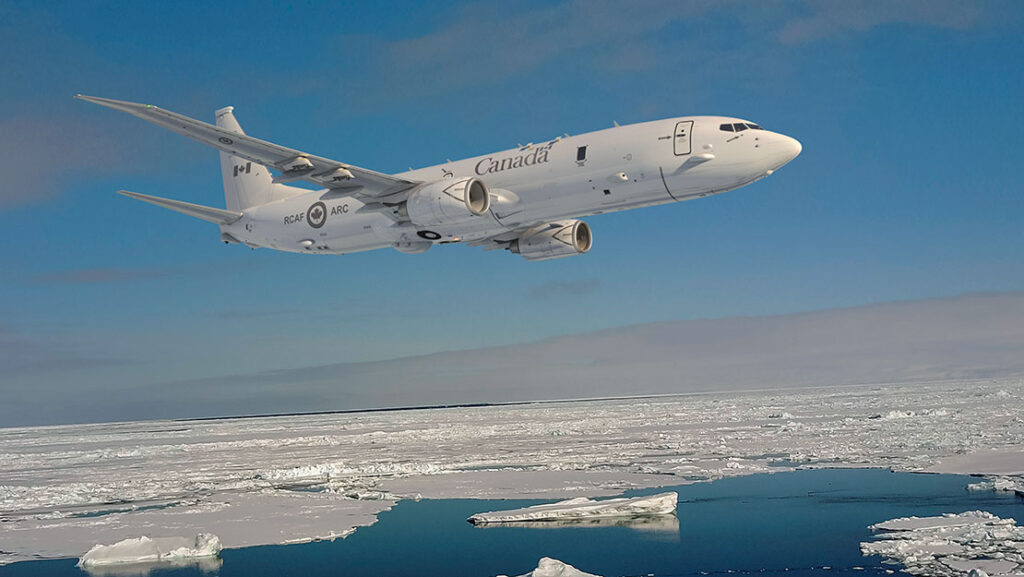
Initial Agreement
The initial agreement includes 14 multi-mission aircraft to be procured, with options for up to two additional planes.
“The estimated investment for this project is $10.4 billion. It includes up to USD $ 5.9 billion for the P-8A, associated equipment, training devices and sustainment set-up. The balance will cover additional investments in simulators, infrastructure and weapons,” noted a press release.
The contract includes Canada’s acquisition of training aids and simulators for the new fleet as they are within the overall project budget and within the current Foreign Military Sale (FMS) case.
“As I’m sure General Kenney and our aviators can attest, today is truly a very good day for the Royal Canadian Air Force,” Minister of National DefenceBill Blair.
Boeing P-8A aircraft
The P-8A will replace Canada’s current maritime patrol aircraft, the CP-140 Aurora, which has been in service for over 40 years.
This press release noted that the agreement will deliver the most modern and advanced equipment to ensure the protection of Canada for years to come.
“Our adversaries are deploying increasingly sophisticated, stealthy, and lethal capabilities; therefore, the Aurora must be replaced,” said the minister of defence at the annoucement.
The new aircraft will be based at 14 Wing Greenwood, N.S. and 19 Wing Comox, B.C. As soon as Canada’s new CC-330 Husky aircraft fleet reaches initial operational capability, it will be able to refuel other aircraft, including the P-8A.
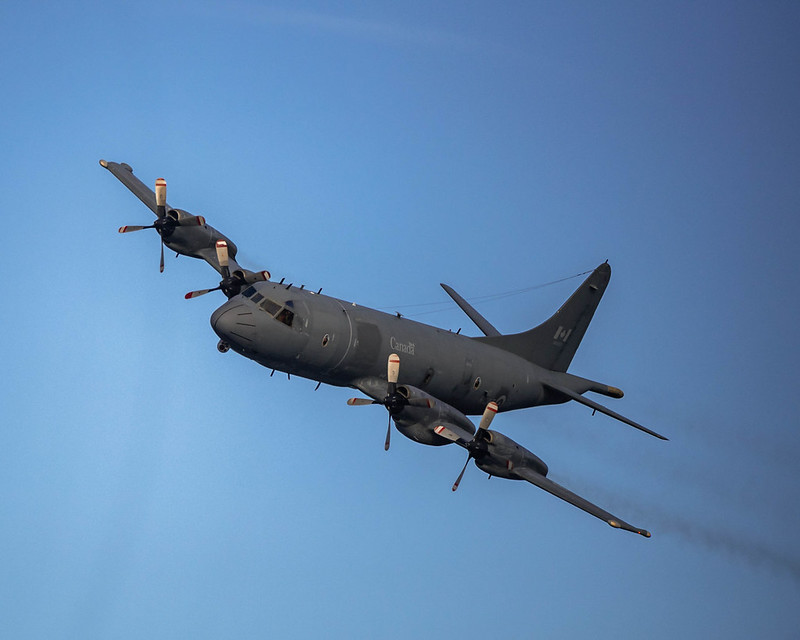
Ensuring RCAF Future
“Our Air Force has an incredibly proud history. We have an obligation to ensure that it has a proud future. Our Air Force must have the tools that they need to do this essential job and the ability to attract the very best and the brightest to serve in its ranks. I believe today we’ve made a significant step forward in ensuring that future,” said Blair.
The P-8A features:
- advanced anti-submarine warfare (ASW),
- anti-surface warfare (ASuW), and
- intelligence, surveillance, reconnaissance (ISR) capabilities
- search and rescue and humanitarian assistance/disaster relief response.
Specializing in anti-submarine and anti-surface warfare, the P-8A is optimal for providing aerial command, control, communications, computers, intelligence, surveillance and reconnaissance (C4ISR) support to coalition air operations.
“This (C4ISR) capability will also be upgradeable, resilient, and interoperable with the RCAF’s joint, interagency, multinational and public partners, and provides an operational advantage over adversaries,” noted the press release.
The Boeing P-8A Poseidon will provide Canada with an advanced multi-mission platform to conduct maritime and overland surveillance in defence of Canada and to support Canada’s allies with integrated C4ISR, anti-submarine and anti-surface capabilities.
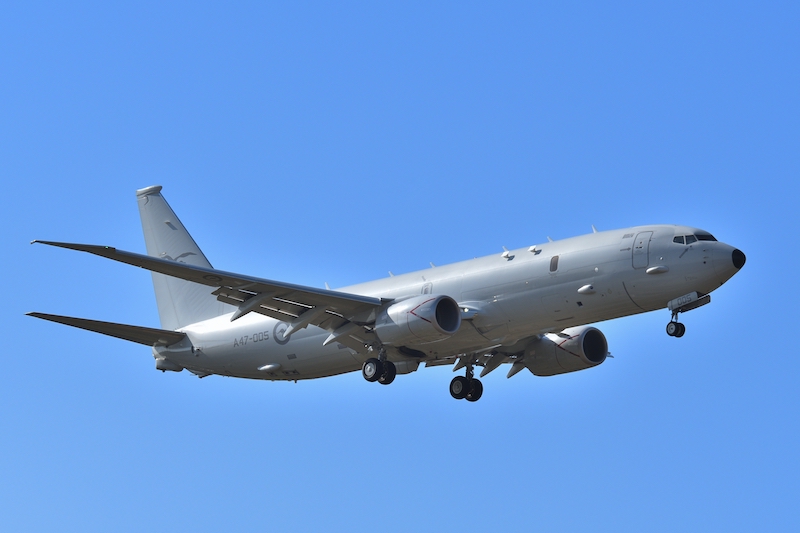
Aligning With Allies
Along with the laundry list of benefits noted at the press conference, the P-8A will operate seamlessly with Canada’s allies as the aircraft is a proven capability used by Canada’s Five Eyes allies:
- the United States,
- the United Kingdom,
- Australia, and
- New Zealand
- as well as other defence partners.
The first Boeing P-8A Poseidon planes are scheduled to arrive in 2026, with the final aircraft delivered as early as the fall of 2027. The government anticipates full operational capability by 2033.
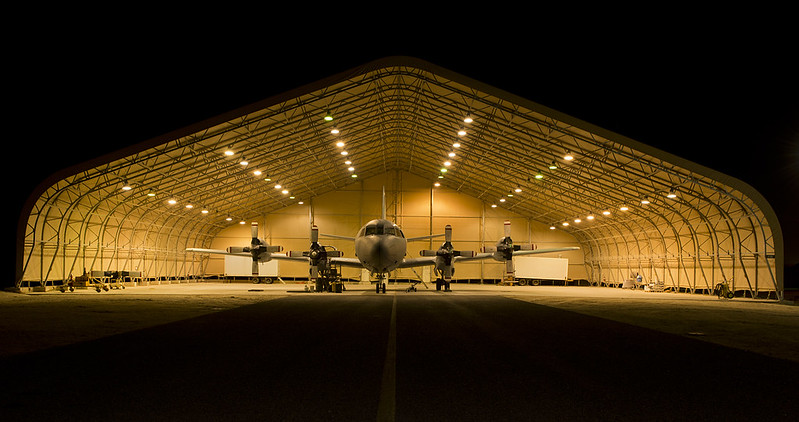
Aurora Fleet
Acquired in 1980, the CH-140 Aurora aircraft has aged and become increasingly challenging to support, expensive to sustain, and less operationally relevant compared to the threats it must defend against, stated the press release.
“The Aurora has done extraordinary services. It’s helped us to detect illegal fishing, drug trafficking, and polluters along our coastlines, which happens to be the longest coastline in the world. It has hunted submarines. It’s protected our Arctic sovereignty. It’s conducted counter-narcotics operations. It’s helped monitor the implementation of the United Nations sanctions against North Korea. It has done its job well, and we’re going to rely on it to continue to serve our country. But the Aurora is becoming increasingly difficult to support, expensive to sustain, and less suited to operating in today’s threat environment,” said the minister of defence.
The CP-140 Aurora fleet is scheduled to retire from service in 2030. At that point, it will have been in service for almost 50 years and will face significant obsolescence challenges.
The U.S. Navy advised the Canadian government of its intent to support the fleet of P-8A aircraft until the 2060s.
Continually Vigilant
The press release noted that to defend Canadian interests in the maritime approaches, the Arctic, and internationally, the RCAF needs to identify, detect, track, and potentially engage advanced surface and sub-surface threats using an array of highly sophisticated sensors and weapons. The RCAF must have self-protection systems that afford our aviators a measure of survivability against known threats.
“The P-8A meets these requirements. It will protect Canadians, enhance our Arctic security and national sovereignty, and enable Canada to meet its NATO, NORAD and other obligations well into the future,” said Blair.
The press release noted, “These aircraft are not just airplanes, but complex weapon systems capable of transporting and launching multiple sonobuoys, torpedoes, and anti-ship weapons to protect Canada’s water on all three coasts.”
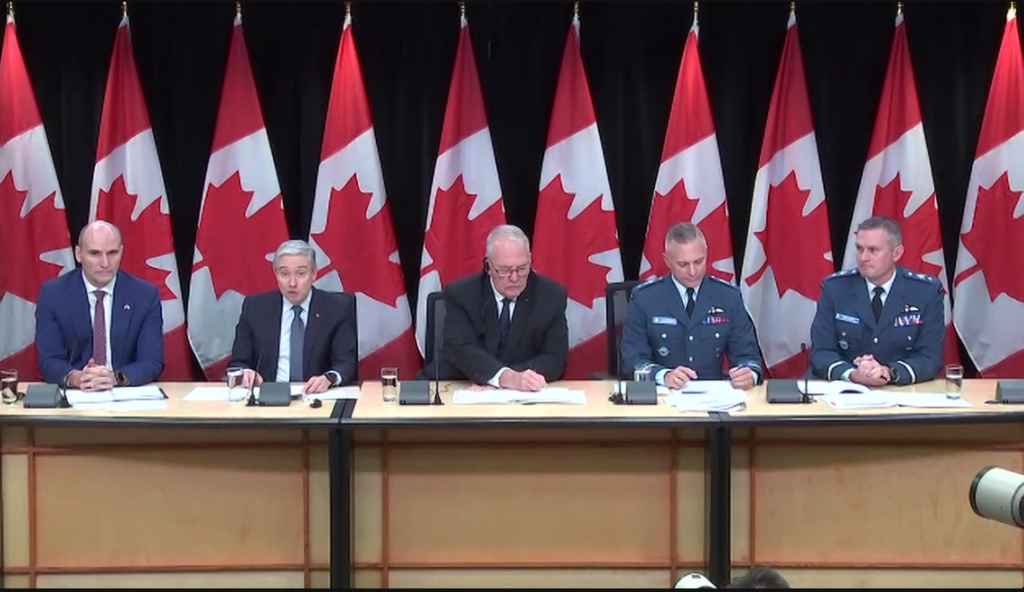
Procurement Process
When asked about the procurement process, having sole-sourced the planes from the U.S. and not a Canadian aircraft company, the Minister of Public Services and Procurement Jean-Yves Duclos said, “The Department of National Defence, they were very clear. They said that the only plane that could be used in order to replace the CP Aurora fleet, that will be obsolete in 2030, the only one that existed and responded to their needs, is the P-8A. And so we examined the issue, and we respected the expertise of national defence, and that was the only way to move forward in order to ensure the national security of the country.”
He added, “We know that Canada needs to operate in a concerning new geopolitical environment, and Canada needs to be able to defend its sovereignty but also support other countries, and that is why we moved to today’s announcement.”
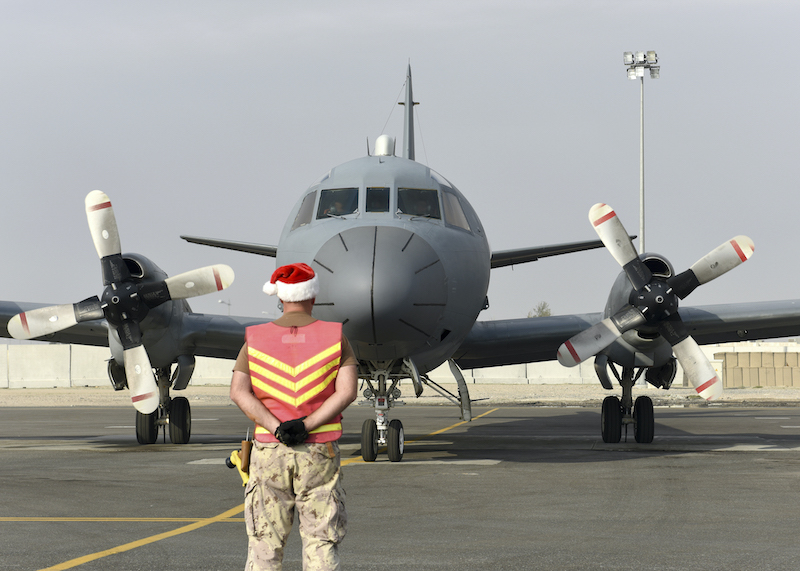
Canada Benefits
Minister François-Philippe Champagne, minister of innovation, science and industry, said as part of the project, Boeing will provide meaningful business activities and make targeted investments in the Canadian industry to support the growth of our aerospace and defence sector. To that end, Boeing has plans to integrate Canadian companies in global supply chains, develop clean technologies and support the development of skills and training in Canada.
Boeing’s economic commitments to Canada has the potential to generate more than 3,000 jobs annually for Canadian industry and value chain partners, contribute at least $358 million annually to Canada’s gross domestic product over 10 years, and will bring benefits to hundreds of Canadian companies.


